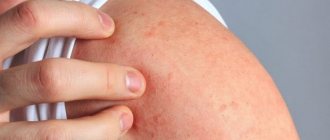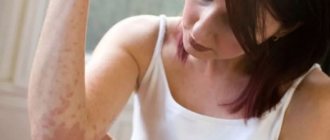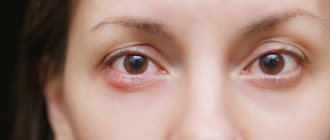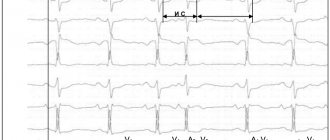Oral dermatitis is a local skin lesion, which consists of small papules (pimples), usually localized around the mouth, which determines the name of the disease. Another name for this disease is perioral dermatitis. Most often, this type of dermatitis is diagnosed in young women, less often in older women, but can also occur in children and teenage boys. Oral (perioral) dermatitis is an unpleasant cosmetic problem, which can still be eliminated if the cause of its occurrence is correctly identified and an effective treatment regimen is selected.
Medical is a clinic that diagnoses and treats many diseases, including dermatological ones. The treatment regimen in each specific case is selected individually, taking into account the characteristics of the patient’s body.
In what cases does perioral dermatitis occur?
The causes of perioral dermatitis are varied. During a detailed interview, the doctor tries to establish the cause of this condition in a particular patient, since further treatment depends on this. Most often, the development of the disease is associated with the following factors:
- prolonged and uncontrolled use of creams and ointments containing corticosteroids;
- the use of fluoride-containing products, for example the use of toothpaste with a high fluoride content;
- prolonged and uncontrolled use of products containing antibiotics;
- prolonged exposure to aggressive components included in some cosmetics and foundations;
- hormonal disorders.
Perioral dermatitis is similar to seborrheic dermatitis, rosacea and other skin diseases, so only a doctor can prescribe an accurate diagnosis and correct treatment. Therefore, only by seeking advice can you understand for sure that this is perioral dermatitis and receive the correct treatment regimen.
Manifestations of the disease
Perioral dermatitis can manifest itself in the chin, eyelids, corners of the lips, nasolabial and nasobuccal folds in the form of single papules, as well as in the form of extensive lesions. Papules are round, convex formations of red or pink color. There is itching and burning in the area of the rash. But there are also cases when papules do not cause any inconvenience other than aesthetic ones.
The affected areas of the skin feel uneven to the touch. In the area of papules, weeping may occur and crusts may subsequently form.
It is worth noting that most often papules form in the chin area and around the mouth rather than on the eyelids. There are also cases of mixed lesions, when papules spread over the entire face.
Possible negative consequences
If you do not seek medical help in time, wounds with pus may form in place of the papules. In this case, the percentage of affected skin will be much greater than at the beginning of the disease. Patients at particular risk are:
- with weakened immunity;
- with hormonal imbalance;
- childhood;
- with concomitant skin diseases.
The course of dermatitis can worsen with the concomitant use of various medications, for example, hormonal contraceptives, as well as during pregnancy, when the skin is exposed to ultraviolet radiation, cold, wind, and dry indoor air.
Diagnosis of the disease
To accurately diagnose this type of dermatitis, you may need not only a doctor’s examination, but also additional manipulations, for example, scraping from the affected area of skin for microscopic examination, bacterial culture. Laboratory diagnostics may reveal:
- presence of demodex mite;
- increased microbial contamination of the skin;
- thinning of the skin with signs of inflammation based on biopsy results.
The difficulty can be considered the absence of a specific causative agent of perioral dermatitis, common for all patients, as well as nonspecific skin changes that may be present in other diseases.
Bibliography
- Adaskevich V.P. Perioral dermatitis: clinical picture, diagnosis, treatment / V.P. Adaskevich // Dermatology. – 2008. – No. 1. – P. 17–20.
- Grashkin V. A. Diagnostic criteria, epidemiology and substantiation of clinical and pathogenetic types of perioral dermatitis / V. A. Grashkin, M. S. Gromov // Voenmed. magazine – 2010. – No. 10. – P. 32–45.
- Rodionov A. N. Dermatocosmetology. Lesions of the facial skin and mucous membranes. Diagnostics, treatment, prevention / A. N. Rodionov. – St. Petersburg. : Science and technology, 2011. – 912 p.
- Karelina O. Yu. Perioral dermatitis: treatment with azelaic acid / O. Yu. Karelina, Yu. M. Karelin // Klin. dermatology and venereology. – 2006.
Treatment of perioral dermatitis
Treatment of perioral dermatitis includes several stages.
Before treating perioral dermatitis , your doctor may recommend a complete detox of your skin and body. First of all, it is necessary to avoid the use of products that cause inflammation. Most often these are hormonal ointments, antibiotic creams or toothpaste with a high fluoride content. When you stop taking these medications, so-called “withdrawal dermatitis” may occur—burning and itching intensify, swelling and redness increase, and rashes literally “spread” all over the face. Such inconveniences can cause the patient to panic and desire to return the medications used to eliminate symptoms. However, this is the wrong path and will only make the situation worse. It is important to fully follow the doctor's instructions.
Since the skin is inflamed, during treatment it is necessary to avoid any products that could increase irritation. In particular, this applies to masking creams, powders, as well as cosmetics that are applied next to or directly on the area where perioral dermatitis appears.
Dietary instructions must also be followed. A diet for perioral dermatitis involves the complete exclusion of foods such as:
- alcohol;
- fast carbohydrates (industrial sweets, confectionery);
- smoked meats;
- hot spices, sauces;
- nuts;
- some types of fruits and vegetables.
Preference should be given to light vegetable dishes and light protein foods. When processing foods, preference should be given to steaming, boiling, stewing or baking.
To relieve the feeling of itching and burning on the skin, the doctor may prescribe antihistamines, and in particularly difficult cases, sedatives.
Skin-cap cream containing activated zinc pyrithione has shown effectiveness as a means for external treatment of dermatitis. The active substance (activated zinc pyrithione) helps eliminate inflammation, rashes, itching and excessive growth of microorganisms that increase inflammation. Skin-cap cream also contains neutral components that additionally moisturize the skin. The cream has a pleasant texture and helps eliminate the feeling of dryness and tightness of the skin.
In addition to the Skin-Cap medicinal cream, the doctor may recommend neutral skin cleansers and frequent irrigation of the affected areas with thermal water.
General symptoms
Characteristic signs for all dermatitis are hyperemia (redness) of the skin, swelling, local increase in temperature, feeling of heat and itching at the site of the lesion. After prolonged contact with the provoking factor or as the disease develops, a vesicular rash, blisters of various types, skin cracks, scabs, and areas of necrosis appear.
Disease prevention
When wondering how to cure perioral dermatitis, special attention should be paid to the prevention of this disease. Below are the main approaches that will reduce the risk of developing perioral dermatitis:
- When choosing cosmetics, it is recommended to give preference to quality products, and also to conduct an allergy test before using new products.
- Corticosteroid-based drugs should be used only on the recommendation of a doctor, without exceeding the recommended course of use.
- External antibiotics should be used only after consultation with a dermatologist for a limited number of days.
- Toothpastes with a high fluoride content should be used only on the recommendation of a dentist; they can be alternated with toothpastes with a neutral composition.
For any skin lesions, personal hygiene is important. This applies to the use of individual makeup brushes, face towels, and you should also avoid touching your face with unwashed hands. During the hot season, use thermal water and, if possible, shade your face with a hat.
Changes in diet can also trigger recurrence of breakouts. Therefore, it is advisable to monitor your diet and exclude from your diet foods that can cause an increased reaction from the skin.
During pregnancy, lactation, preparation for conception and treatment of gynecological diseases, exacerbation of perioral dermatitis may occur. If repeated rashes appear, you should immediately consult a doctor. This will help minimize the affected area and quickly return the skin to a healthy appearance.
Risk factors for the development of rosacea
The incidence of rosacea is approximately the same in both sexes, but women during menopause are more susceptible to rosacea, as hormonal levels and vascular properties change. Blondes and redheads with thin, sensitive skin prone to redness are at risk for rosacea. Allergic and contact dermatitis can provoke rosacea, since the blood vessels are often dilated and subsequently their return to their previous state is no longer possible.
Genetically, residents of northern peoples are more predisposed to rosacea; living in extreme continental climates and in northern countries also increases the risk of rosacea.
Diseases and disorders of the endocrine system, diseases of the gastrointestinal tract and disorders of the immune system, especially when combined with each other, lead to rosacea. The pathogenesis of rosacea is not fully understood, but most dermatologists agree that exposure to hot or cold areas, wind, and consumption of excessively burning foods, alcohol and spices provoke rosacea.
Symptoms and causes of seborrheic dermatitis
The first warning signs of seborrheic dermatitis are redness, severe itching and peeling of the skin near the wings of the nose, eyelashes, eyebrows and cheekbones. This is because in these places the maximum number of sebaceous glands are located, showing excessive activity. The disease mainly affects men from 20 to 50 years old, but young girls are also often affected. Most often, exacerbations occur in winter. Experts believe that this condition is caused by disturbances in the digestive tract and a disorder of the nervous system. Treating the underlying cause will help eliminate painful skin manifestations. The causes of seborrheic dermatitis can be: heredity, chronic stress, HIV infection, unbalanced diet, malfunction of the thyroid gland.
Prices for services
- Dermatoscopy (skin diagnostic method) 300a
- Fluorescent diagnostics (examination under Wood's lamp) 440a
- Examination of the skin through glass with pressure (vitropression) 495a
- Obtaining scrapings from erosive and ulcerative elements of the skin and mucous membranes 385a
- Repeated appointment (examination, consultation) with a dermatovenerologist 1210a
- Primary appointment (examination, consultation) with a dermatovenerologist 1375a
The information and prices presented on the website are for reference only and do not constitute a public offer.
Diet
Diet is very important for the prevention of dermatitis and their treatment in both adults and children. Foods that provoke allergies should be excluded from the menu: citrus fruits, nuts, red fish, eggs, chocolate, honey. It is recommended to limit irritating foods as much as possible - spices, vinegar, salty, spicy and smoked foods. Patients are advised to take light soups, low-fat foods, and fermented milk products. It is necessary to drink enough water.
For infants suffering from atopic dermatitis, it is advisable to continue breastfeeding. At the same time, the mother should exclude allergens from her food as much as possible. If breastfeeding is not possible, the child is prescribed special formulas with a minimum content of cow's milk protein. Complementary feeding is introduced to such children as late as possible, with extreme caution. Each new product and the reaction to it should be recorded in a food diary.
Article sources:
- Characteristics of seborrheic dermatitis. Shukurov I.B., Yakhshieva M.F., Rustamov M.K. Scientific journal, 2018
- Atopic dermatitis of adults. Dvoryankova E., Denisova E., Piruzyan A., Korsunskaya I. Doctor No. 3, 2021. p. 9-13
- Maintenance pharmacotherapy for atopic dermatitis. Petrova I.V., Omarov N.N., Sargsyan M.S., Khamroeva S.A., Osmanova Z.S., Proshin S.N. Reviews on clinical pharmacology and drug therapy, 2021. p. 60-63









